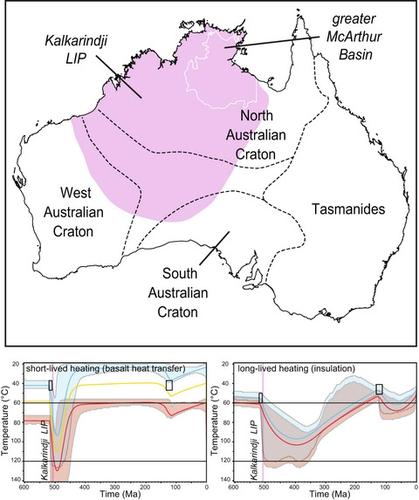当前位置:
X-MOL 学术
›
Basin Res.
›
论文详情
Our official English website, www.x-mol.net, welcomes your
feedback! (Note: you will need to create a separate account there.)
Low-temperature thermal history of the McArthur Basin: Influence of the Cambrian Kalkarindji Large Igneous Province on hydrocarbon maturation
Basin Research ( IF 2.8 ) Pub Date : 2022-07-04 , DOI: 10.1111/bre.12691 Angus L. Nixon 1, 2 , Stijn Glorie 1, 2 , Derrick Hasterok 1 , Alan S. Collins 1, 2 , Nicholas Fernie 3 , Geoffrey Fraser 4
Basin Research ( IF 2.8 ) Pub Date : 2022-07-04 , DOI: 10.1111/bre.12691 Angus L. Nixon 1, 2 , Stijn Glorie 1, 2 , Derrick Hasterok 1 , Alan S. Collins 1, 2 , Nicholas Fernie 3 , Geoffrey Fraser 4
Affiliation

|
The McArthur Basin of the North Australian Craton is one of the very few places on Earth where extensive hydrocarbons are preserved that were generated from Mesoproterozoic source rocks, prior to the development of extensive multicellular life. It is, however, unclear precisely when hydrocarbons from these source rocks matured, and if this occurred as a singular event or multiple phases. In this study, we present new apatite fission track data from a combination of outcrop and sub-surface samples from the McArthur Basin to investigate the post-depositional thermal history of the basin, and to explore the timing of hydrocarbon maturation. Apatite fission track data and thermal modelling suggest that the McArthur Basin experienced a basin-wide reheating event contemporaneous with the eruption of the Cambrian Kalkarindji Large Igneous Province in the North and West Australian cratons, during which thick (>500 m) basaltic flows blanketed the basin surface. Reheating at ca. 510 Ma coinciding with Kalkarindji volcanism is consistent with a proposed timing of elevated hydrocarbon maturation, particularly in the Beetaloo Sub-basin, and provides a mechanism for petroleum generation throughout the basin. Subsequent regional cooling was slow and gradual, most likely facilitated by gentle erosion (ca. 0.01–0.006 km/Ma) of overlying Georgina Basin sediments in the Devonian–Carboniferous with little structural reactivation. This model provides a framework in which hydrocarbons, sourced from Mesoproterozoic carbon-rich rocks, may have experienced thermal maturation much later in the Cambrian. Preservation of these hydrocarbons was aided by a lack of widespread structural exhumation following this event.
中文翻译:

麦克阿瑟盆地的低温热史:寒武纪 Kalkarindji 大火成岩省对油气成熟度的影响
北澳大利亚克拉通的麦克阿瑟盆地是地球上为数不多的保存了大量碳氢化合物的地方之一,这些碳氢化合物是在广泛的多细胞生命发展之前从中元古代烃源岩中产生的。然而,尚不清楚这些烃源岩中的碳氢化合物何时成熟,以及这是作为单一事件还是多个阶段发生。在这项研究中,我们提供了来自麦克阿瑟盆地露头和地下样品组合的新磷灰石裂变径迹数据,以研究盆地沉积后的热历史,并探索油气成熟的时间。磷灰石裂变径迹数据和热模型表明,麦克阿瑟盆地经历了一次全盆地再加热事件,与北澳大利亚和西澳大利亚克拉通的寒武纪 Kalkarindji 大火成岩省的喷发同时发生,在此期间,厚厚的 (>500 m) 玄武岩流覆盖了整个盆地盆面。大约重新加热。510 Ma 与 Kalkarindji 火山活动相吻合,这与提出的油气成熟度升高的时间一致,特别是在 Beetaloo 次盆地,并提供了整个盆地石油生成的机制。随后的区域冷却缓慢而渐进,很可能是由于泥盆纪 - 石炭纪上覆乔治娜盆地沉积物的温和侵蚀(约 0.01-0.006 公里/ Ma),几乎没有结构活化。该模型提供了一个框架,其中碳氢化合物,源自中元古代的富碳岩石,可能在寒武纪晚期经历了热成熟。此次事件后没有广泛的结构挖掘有助于保存这些碳氢化合物。
更新日期:2022-07-04
中文翻译:

麦克阿瑟盆地的低温热史:寒武纪 Kalkarindji 大火成岩省对油气成熟度的影响
北澳大利亚克拉通的麦克阿瑟盆地是地球上为数不多的保存了大量碳氢化合物的地方之一,这些碳氢化合物是在广泛的多细胞生命发展之前从中元古代烃源岩中产生的。然而,尚不清楚这些烃源岩中的碳氢化合物何时成熟,以及这是作为单一事件还是多个阶段发生。在这项研究中,我们提供了来自麦克阿瑟盆地露头和地下样品组合的新磷灰石裂变径迹数据,以研究盆地沉积后的热历史,并探索油气成熟的时间。磷灰石裂变径迹数据和热模型表明,麦克阿瑟盆地经历了一次全盆地再加热事件,与北澳大利亚和西澳大利亚克拉通的寒武纪 Kalkarindji 大火成岩省的喷发同时发生,在此期间,厚厚的 (>500 m) 玄武岩流覆盖了整个盆地盆面。大约重新加热。510 Ma 与 Kalkarindji 火山活动相吻合,这与提出的油气成熟度升高的时间一致,特别是在 Beetaloo 次盆地,并提供了整个盆地石油生成的机制。随后的区域冷却缓慢而渐进,很可能是由于泥盆纪 - 石炭纪上覆乔治娜盆地沉积物的温和侵蚀(约 0.01-0.006 公里/ Ma),几乎没有结构活化。该模型提供了一个框架,其中碳氢化合物,源自中元古代的富碳岩石,可能在寒武纪晚期经历了热成熟。此次事件后没有广泛的结构挖掘有助于保存这些碳氢化合物。










































 京公网安备 11010802027423号
京公网安备 11010802027423号